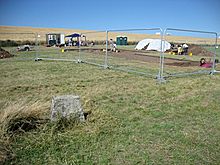|
|
|
|
West Kennet Avenue Settlement SiteAncient Village / Settlement / Misc. Earthwork
|
||||||||||||||||||||||||
|
|
|
News |
|
Update on second year dig at Avebury WK Avenuehttp://www.marlboroughnewsonline.co... continues... |
 Posted by tjj
Posted by tjj6th August 2014ce Edited 6th August 2014ce |
|
Avebury Dig Ends Soon Although news of the latest dig at Avebury failed to make it to the TMA in real time, you can catch up with some of the events here...... West Kennet Avenue Settlement Site - http://www.ntarchaeostonehengeaveburywhs.wordpress.com |
 Posted by Chance
Posted by Chance8th August 2013ce |
Images (click to view fullsize) |
|
Photographs:






















 Artistic / Interpretive:
Artistic / Interpretive:
|
Fieldnotes |
|
|
This site has mystery written all over it, one being why the TMA ed's have not listed it under the West Kennet Avenue. For the past 78 years, all you could see of this site is the unique, flat topped concrete post that marks the area out from the rest of the Avenue. What a lovely Lammas surprise then to find a caged area with a possie of sweaty archo's crawling all over it's subterranean, back to natural, features. Digging anywhere around Avebury draws the crowds and a "meeter and greeter" is a must if the archo's are to get down and dirty. I speak from direct experience of the Saxon car park dig in 1988 when every bus load of tourists walked over the site, asking questions and taking pictures, which added days to the dig schedule. It seemed the NT volunteers I spoke to had all been briefed from the same script and it was not until my third visit that I got the full low-down from "Dr.Nic". It would have been easier to update my knowledge by reading the daily blog set up to supply a less than eager world with the latest word, but it seems to have gone unnoticed on channel TMA. Site Background In 1934 and 1935 Alexander Keiller excavated the part of the West Kennet Avenue that runs immediately south from Avebury Henge and the stone circles. Along most of the length that Keiller dug, he found a large hole had been dug in the medieval period, the standing stone pushed over into it and then buried. Here Keiller re-erected the stone in its original position. In other cases only the original socket that the Neolithic people had dug to stand the stone upright survived. Here Keiller placed small concrete obelisks to mark where they had once stood. But there was one location where Keiller found neither stone nor socket. Instead he found the remains of a large rubbish heap (or midden) together with a number of holes and pits that had been dug into the ground. The finds from this midden show that the site was in use at the beginning of the later Neolithic. This may have been at the time, or a little before, the very earliest parts of the henge and stone circles were being built. Keiller identified this as an occupation site. At least part of this must have been visible when builders of the Avenue put the sarsen stones in place because instead of putting up a stone here they decided to leave a gap and incorporate it into their scheme. The current dig is part of the "Between the Monuments" investigation which is trying to identify where the ancient people who built Avebury, lived and worked. Between the monuments is a collaborative research project set up between the university of Southampton (Dr. Josh Pollard), university of Leicester (Dr. Mark Gillings), Allen Environmental archaeology (Dr. Mike Allen) and the national Trust (Dr. Ros Cleal & Dr. Nic Snashall). Although it was very interesting to talk to "Dr.Nic", the results of this dig will not become clear until after the investigations are finished. I was granted permission to take photos of the site and some of the flint finds. One thing that came over clearly, and was pointed out by all the "Dr.s" and diggers, was the time and effort the Keiller team had put into both the 1930's excavation. They all commented on how carefully the area of the original diggers had been at uncovering artefacts and how carefully it had been back filled with the relevant strata and sub-soil. The overall conclusion I gleamed was that it was more of a working site that habitation site. There were no bones, apart from more modern sheep ones and nearly all the other finds where the result of being washed down from the later settlement on Waden Hill above. The flints seemed to have been purposely buried in groups, not lost individually. Some of the flints were thought to be Paleolithic in age and again, purposely buried in pre-dug pits. The dig also revealed how the natural sub-terrain had been carved out by glacial action at the end of the last ice age, leaving a series of circle features. If funding is forthcoming, the site may well be re-investigated at the same time next year. Watch this space. |
 Posted by Chance
Posted by Chance8th August 2013ce |
Miscellaneous |
|
|
Details of site on Pastscape Ne occupation site was discovered by Piggott and Keiller in 1934, along the West Kennet Avenue (see plan) between stones 27 and 32, 10706925, which antedated the Avenue across it (see SU 16 NW 22.2). A number of hearths or fire-pits and two rubbish pits were excavated and the whole area yielded Peterborough and Rinyo-Clacton sherds, petit tranchet derivatives, knives, scrapers with polished edges, two fragments of Niedermendig Lava, arrowhead of Portland chert, and two fragments of axes of Graig Lwyd stone. Finds now in Devizes Museum. (1-3) No surface evidence. (4) Discussion of finds from the site. See Avebury (SU 16 NW 22) and West Kennet Avenue (SU 16 NW 101) for additional bibliography] (5) |
 Posted by Chance
Posted by Chance29th October 2012ce |

